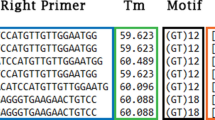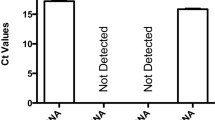Abstract
Genetic markers are widely applied in the study of genetic diversity for many species. The approach incorporates a Polymerase Chain Reaction (PCR) amplification of targeted sequences in the genome. Crucial for the overall success of a PCR experiment is the careful design of synthetic oligonucleotide primers. Ideally designed primer pairs will ensure the efficiency and specificity of the amplification reaction, resulting in a high yield of the desired amplicon. Important criteria such as primer-sequence, −length, and -melting temperature (Tm) are fundamental for the selection of primers and amplification of targeted nucleotide sequences from a DNA template. There are many computational tools available to assist with critical bioinformatics issues related to primer design. These resources allow the user to define parameters and criteria that need to be taken into account when designing primers. Following the initial in silico selection, a primer pair should be further tested in vivo for their amplification efficiency and robustness.
Using examples taken from genetic diversity studies in a marine crustacean, this chapter provides outlines for the application of PCR technology and discusses details for the design of primers for the development and characterization of microsatellite and SNP-markers.
Access this chapter
Tax calculation will be finalised at checkout
Purchases are for personal use only
Similar content being viewed by others
References
Seeb LW, Templin WD, Sato S et al (2011) Single-nucleotide polymorphisms across a species’ range: Implications for conservation studies of Pacific salmon. Mol Ecol Resour 11:195–217
Ward RD (2000) Genetics in fisheries management. Hydrobiologia 420:191–201
Vignal A, Milan D, SanCristobal M et al (2002) A review on SNP and other types of molecular markers and their use in animal genetics. Genet Sel Evol 34:275–305
Delghandi M, Afzal H, Al Hinai MSN et al (2016) Novel polymorphic microsatellite markers for Panulirus ornatus and their cross-species primer amplification in Panulirus homarus. Anim Biotechnol 27:310–314
Delghandi M, Goddard S, Jerry DR et al (2016) Novel genomic microsatellite markers for genetic population and diversity studies of tropical scalloped spiny lobster (Panulirus homarus) and their potential application in related Panulirus species. Genet Mol Res 15
Moen T, Delghandi M, Wesmajervi MS et al (2009) A SNP/microsatellite genetic linkage map of the Atlantic cod (Gadus morhua). Anim Genet 40:993–996
Moya L, Lai J, Hoffman A et al (2018) Association analysis of a microsatellite repeat in the TRIB1 gene with prostate cancer risk, aggressiveness and survival. Front Genet 9:428
Willems T, Gymrek M, Highnam G et al (2014) The landscape of human STR variation. Genome Res 24:1894–1904
Ishiura H, Doi K, Mitsui J et al (2018) Expansions of intronic TTTCA and TTTTA repeats in benign adult familial myoclonic epilepsy. Nat Genet 50:581–590
Nair RR, Tibbit C, Thompson D et al (2020) Sizing, stabilising, and cloning repeat-expansions for gene targeting constructs. Methods 191:15–22
Al-Breiki RD, Kjeldsen SR, Afzal H et al (2018) Genome-wide SNP analyses reveal high gene flow and signatures of local adaptation among the scalloped spiny lobster (Panulirus homarus) along the Omani coastline. BMC Genomics 19(1):690
Kjeldsen SR, Zenger KR, Leigh K et al (2016) Genome-wide SNP loci reveal novel insights into koala (Phascolarctos cinereus) population variability across its range. Conserv Genet 17:337–353
Lal MM, Southgate PC, Jerry DR et al (2017) Swept away: ocean currents and seascape features influence genetic structure across the 18,000 km indo-Pacific distribution of a marine invertebrate, the black-lip pearl oyster Pinctada margaritifera. BMC Genomics 18:66
Aiello MM, Solinas C, Santoni M et al (2020) Excision Repair Cross Complementation Group 1 Single-Nucleotide Polymorphisms and Nivolumab in Advanced Non-Small Cell Lung Cancer. Front Oncol 10:1161
Gallerano D, Ciminati S, Grimaldi A et al (2020) Genetically driven CD39 expression shapes human tumor-infiltrating CD8+ T-cell functions. Int J Cancer 147:2597–2610
Sepulveda-Villegas M, Elizondo-Montemayor LTrevino V (2020) Identification and analysis of 35 genes associated with vitamin D deficiency: a systematic review to identify genetic variants. J Steroid Biochem Mol Biol 196:105516
Raafat Rowida I, Eshra KA, El-Sharaby RM et al (2020) Apa1 (rs7975232) SNP in the vitamin D receptor is linked to hepatocellular carcinoma in hepatitis C virus cirrhosis. Br J Biomed Sci 77:53–57
Wesmajervi MS, Tafese T, Stenvik J et al (2007) Eight new microsatellite markers in Atlantic cod (Gadus morhua L.) derived from an enriched genomic library. Mol Ecol Notes 7:138–140
Delghandi M, Wesmajervi MS, Mennen S et al (2008) Development of twenty sequence-tagged microsatellites for the Atlantic cod (Gadus morhua L.). Conserv Genet 9:1395–1398
Dao HT, Todd EV, Jerry DR (2013) Characterization of polymorphic microsatellite loci for the spiny lobster Panulirus spp. and their utility to be applied to other Panulirus lobsters. Conserv Genet Resour 5:43–46
Coates BS, Sumerford DV, Miller NJ et al (2009) Comparative performance of single-nucleotide polymorphism and microsatellite markers for population genetic analysis. J Hered 100:556–564
Morse P, Kjeldsen SR, Meekan MG et al (2018) Genome-wide comparisons reveal a clinal species pattern within a holobenthic octopod-the Australian southern blue-ringed octopus, Hapalochlaena maculosa (Cephalopoda: Octopodidae). Ecol Evol 8:2253–2267
Moen T, Hayes B, Nilsen F et al (2008) Identification and characterisation of novel SNP markers in Atlantic cod: evidence for directional selection. BMC Genet 9:18
Delghandi M, Saif Nasser Al Hinai M, Afzal H et al (2017) Parentage analysis of tropical spiny lobster (Panulirus homarus) by microsatellite markers. Aquac Res 48:4718–4724
Dawson MN, Raskoff KA, Jacobs DK (1998) Field preservation of marine invertebrate tissue for DNA analyses. Mol Mar Biol Biotechnol 7:145–152
Sambrook J, Russell DW (2001) Molecular cloning: a laboratory manual. Cold Spring Harbor Laboratory Press, New York
Westgaard JI, Tafese T, Wesmajervi MS et al (2007) Identification and characterisation of thirteen new microsatellites for Atlantic cod (Gadus morhua L.) from a repeat-enriched library. Conserv Genet 8:749–751
Delghandi M, Wesmajervi MS, Mennen S et al (2009) New polymorphic di-nucleotide microsatellite markers for Atlantic cod (Gadus morhua L.). Conserv Genet 10:1037–1040
Meglecz E, Costedoat C, Dubut V et al (2010) QDD: a user-friendly program to select microsatellite markers and design primers from large sequencing projects. Bioinformatics 26:403–404
Faircloth BC (2008) MSATCOMMANDER: detection of microsatellite repeat arrays and automated, locus-specific primer design. Mol Ecol Resour 8:92–94
Brownstein MJ, Carpten JD, Smith JR (1996) Modulation of non-templated nucleotide addition by taq DNA polymerase: primer modifications that facilitate genotyping. BioTechniques 20:1004–1006
Wesselmann M, Gonzalez-Wanguemert M, Serrao EA et al (2018) Genetic and oceanographic tools reveal high population connectivity and diversity in the endangered pen shell Pinna nobilis. Sci Rep 8:4770
Dao HT, Smith-Keune C, Wolanski E et al (2015) Oceanographic currents and local ecological knowledge indicate, and genetics does not refute, a contemporary pattern of larval dispersal for the ornate spiny lobster, Panulirus ornatus in the South-East Asian Archipelago. PLoS One 10:e0124568
Kennington WJ, Cadee SA, Berry O et al (2013) Maintenance of genetic variation and panmixia in the commercially exploited western rock lobster (Panulirus cygnus). Conserv Genet 14:115–124
Jombart T, Devillard SBalloux F (2010) Discriminant analysis of principal components: a new method for the analysis of genetically structured populations. BMC Genet 11:94
Neuditschko M, Khatkar MS, Raadsma HW (2012) NETVIEW: a high-definition network-visualization approach to detect fine-scale population structures from genome-wide patterns of variation. PLoS One 7:e48375
Steinig EJ, Neuditschko M, Khatkar MS et al (2016) NETVIEW P: a network visualization tool to unravel complex population structure using genome-wide SNPs. Mol Ecol Resour 16:216–227
Tamura K, Stecher G, Peterson D et al (2013) MEGA6: molecular evolutionary genetics analysis version 6.0. Mol Biol Evol 30:2725–2729
Jombart T (2008) Adegenet: a R package for the multivariate analysis of genetic markers. Bioinformatics 24:1403–1405
http://www.sequenom.com
Tang K, Fu DJ, Julien D et al (1999) Chip-based genotyping by mass spectrometry. Proc Natl Acad Sci U S A 96:10016–10020
Jaccoud D, Peng K, Feinstein D et al (2001) Diversity arrays: a solid state technology for sequence information independent genotyping. Nucleic Acids Res 29:E25
Kilian A, Wenzl P, Huttner E et al (2012) Diversity arrays technology: a generic genome profiling technology on open platforms. Methods Mol Biol 888:67–89
Sansaloni C, Petroli C, Jaccoud D, Carling J, Detering F, Grattapaglia D, Kilian A (2011) Diversity Arrays Technology (DArT) and next-generation sequencing combined: genome-wide, high-throughput, highly informative genotyping for molecular breeding of Eucalyptus. BMC Proc 5(Suppl 7):P54
Lind C, Kilian ABenzie J (2017) Development of diversity arrays technology markers as a tool for rapid genomic assessment in Nile tilapia, Oreochromis niloticus. Anim Genet 48:362–364
Li WGodzik A (2006) Cd-hit: a fast program for clustering and comparing large sets of protein or nucleotide sequences. Bioinformatics 22:1659
Purcell S, Neale B, Todd-Brown K et al (2007) PLINK: a tool set for whole-genome association and population-based linkage analyses. Am J Hum Genet 81(3):559–575
Excoffier LLischer HEL (2010) Arlequin suite ver 3.5: a new series of programs to perform population genetics analyses under Linux and windows. Mol Ecol Resour 10:564–567
Weir BCockerham C (1984) Estimating F statistics for the analysis of population structure. Evolution 38:1358–1370
Belkhir K, Borsa P, Chikhi L et al (1996) GENETIX 4.05, logiciel sous Windows TM pour la génétique des populations. Lab Génome Popul Interact CNRS Umr 5000:1996–2004
Acknowledgments
This work was supported by the Research Council of Oman (TRC) (ORG/SQU/EBR/13/027) and by the Deanship of Research at the Sultan Qaboos University (IG/DVC/CEMB/14/01). We acknowledge all researchers, students, and members of the research group for their contributions to these projects.
Author information
Authors and Affiliations
Corresponding author
Editor information
Editors and Affiliations
Rights and permissions
Copyright information
© 2022 Springer Science+Business Media, LLC, part of Springer Nature
About this protocol
Cite this protocol
Delghandi, M., Delghandi, M.P., Goddard, S. (2022). The Significance of PCR Primer Design in Genetic Diversity Studies: Exemplified by Recent Research into the Genetic Structure of Marine Species. In: Basu, C. (eds) PCR Primer Design. Methods in Molecular Biology, vol 2392. Humana, New York, NY. https://doi.org/10.1007/978-1-0716-1799-1_1
Download citation
DOI: https://doi.org/10.1007/978-1-0716-1799-1_1
Published:
Publisher Name: Humana, New York, NY
Print ISBN: 978-1-0716-1798-4
Online ISBN: 978-1-0716-1799-1
eBook Packages: Springer Protocols




